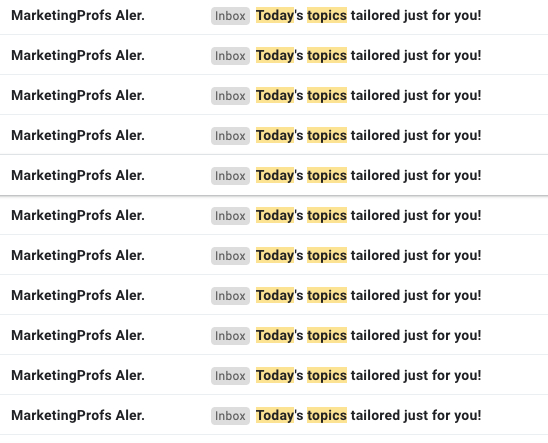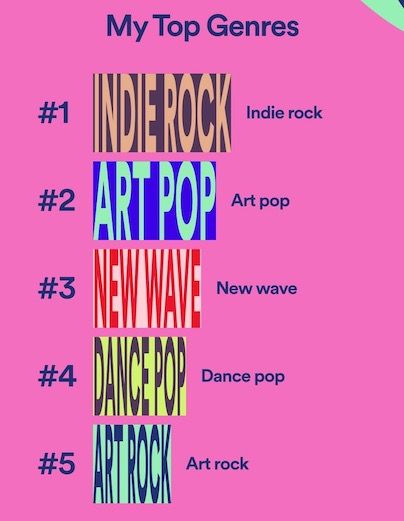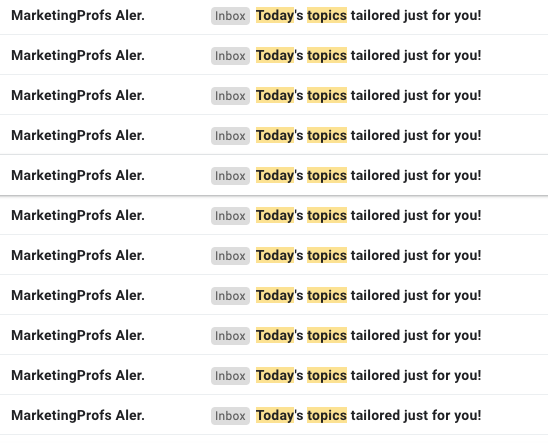This essay originally was published on September 9, 2021, with the email subject line CT No. 94: "Not so good, better, best."
True personalization of a content experience, wherein a user receives a content experience tailored to their tastes and preferences, is not an easy accomplishment. Like many web tech experiences, the promise of personalization gleams a little bit brighter than the execution, especially with the current capabilities in machine learning.
The first installment of this series defined six common tactics often described as personalization; the second brought up two major problems with the operation and user experience of personalization. In this third and final installment, for paid and founding Content Technologist members only, we'll look at a variety personalization experiences in the wild in both consumer and business media.
Personalization tactics in email: From spammy subject lines to true customization
Email tech accommodated many personalization tactics long before we heralded the return of the email newsletter as the next big thing. In the mid-2010s, email was trying desperately to be sexy, trumpeting its advantages as the only real cross-platform medium with a unique user ID. Advanced email tech and marketing automation software systems can accommodate dynamic, segmented content; customized triggers based on automated actions; and preferences in when and how often email is delivered.
So how's email personalization doing these days?
Not so good: personalized emails, same subject line
One of the biggest B2B media sites for digital marketers, MarketingProfs, likely has performed many experiments with email segmentation and personalization, but I have received none. Why? Because I have no idea what's in the email.
Although they're supposedly "tailored just for you," the subject line is same same same all the way down the board.

Solution: If you're going to personalize the content of the email, maybe you should also attempt to personalize the email subject line so that I am enticed to open. Also, scrub your lists for people who never open your emails! It will improve your open rate and sender reputation.
Good: First-touch behavioral segmentation
When you opt into a brand's website with your email address, sometimes marketing automation systems intuit that you only want to see content about the topic you viewed that day you signed up, and no other content.
Segmentation like this is typically used in sales automations, typically after a user has downloaded a lead gen deliverable like a whitepaper. Two weeks after you download the whitepaper, a sales rep from the company follows up with another piece of content around the exact same topic. If you're me, after the fifth or so communication about this one topic, you unsubscribe, dismissing the brand or mailing list as a one-trick pony. I'm sure other people like it, I guess. It's a tactic that gets ok results for lead gen, but doesn't do much for building a content brand.
Better: Email customization by topic
I love a user portal for email newsletters. It's pretty sweet when I get to look at all of a brand's emails and opt into the ones I am interested in receiving. Digital-first media companies like Axios and Tech Crunch have focused on their user portal experience, and they clearly find success: let curious, media-friendly users see all your newsletter products and opt into the ones they want. They know they can opt out at any time, and feel some control of their brand experience.
That experience is the opposite of many legacy media companies' email strategies, when you are just dumped onto every single mailing list for the brand the second you opt in. I'm still opting out of promotional emails from my local newspaper, assorted Condé brands, and the Wall Street Journal. Legacy media, do better with email!
Best: Email customization by topic and send time
Is there an email automation I love more than Send Time optimization? With send time optimization, machine learning systems understand what time of day you are most likely to open their email, and then schedule the email to send the hour before.
Send time optimization, however, is only available with swanky, enterprise email products. Little guys like Ghost and even Mailchimp are fairly limited with user-level machine learning.
That said, email personalization can really be knocked out of the park with both frequency and topic opt-in options in an email user center. I don't need to read email on certain topics every day, but it's nice to get a wrap-up once a month. (Axios and Tech Crunch again come to mind, but other media brands are rising to the challenge of creating better, more customized opt-in emails.)
Honorable mention: Machine learning through email content
The promise of The Sample's* machine learning and email rating system is pretty cool. If you subscribe to The Sample, you're forwarded a different email daily on a variety of topics. You can rate the email's relevance and provide notes on topics, supplying the machine with more data to read your tastes. It's like the old Netflix personalization system for email newsletters, perfect for discovery as long as you don't mind the occasional complete content miss.
*There's a referral code attached here, FYI. I'm currently running an ad experiment with The Sample to surface my content more often. We'll see what happens!
Personalization in entertainment products: Big data, big preferences
Last week's screed about how I'm tired of being sold the band Interpol speaks to my expectations of entertainment personalization: super high! Both Spotify and Netflix have on some occasion sincerely impressed me with their abilities to predict my taste and serve new content.
Now with umpteen streaming services, more rickety personalization systems are showing their faces as big media brands try to Get It Right to keep you logged in, always watching. Mostly, it's ok. Not great and not bad either... kindof like flipping through cable channels. Here's where it goes right and wrong:
Not so good: Rough "personalization" based on gender and age
It never fails: as soon as an entertainment brand learns that I am a woman in my 30s, I am aggressively marketed true crime. It's pretty sexist! I don't like true crime, and I think it's weird that our culture produces so much crime-related content when we live in a relatively safe society. Except for The Jinx and that first season of Serial, I haven't ever consumed that much true crime content. If you tell me you're personalizing my experience, please don't try to sell me true crime.
And it's not just me. I've teased my partner because the algorithms push Drake his way, when all behavioral data says I'm the one more likely to try out Certified Lover Boy. In his Netflix profile, I see far more military and law enforcement content promoted, shows and films that neither of us would choose. It's not like either of us straight cis middle-aged white people is in a neglected taste cluster; we have plenty of options. But it definitely makes an individual feel like a weirdo when they have to repeatedly say no to the content "personalized" for them.
Good: Thumbs up, thumbs down
The whole content world is Reddit: thumbs up or thumbs down. No nuance. "Two sides." Thumbs up/thumbs down rating systems are prevalent on streaming services, giving the content consumer some say in what they like while maintaining the predominantly passive nature of entertainment media.
Better: The third, passive option that no one uses
In a thumbs up-thumbs down ranking system, computers can read a third option: no choice at all. It baffles me that impression capping isn't implemented in streaming systems, that no matter how many times I don't choose True Crime, it's still thrown at me. Entertainment companies have the tech to learn what people pass by, over and over again... and yet they never replace that passed over content with something else from the archives. Anyway, this is just a wishlist and a shout into the void, in case you're listening, streaming services.
Best: Old Netflix
Remember when Netflix had a five-point star rating system for all the movies, whether you could get the discs or not, whether it was streaming or not. And then Netflix told me what I would like and they were always right? Anyway, they switched to a two-point system because more people will use a two-point rating system than a five-point star system, and also because a five-point recommender system likely uses more energy/resources the more you scale. Now Netflix just sits on that predictive analytics taste data that they extracted from me and all the Quirky Indie Movies with a Strong Female Lead that they used to recommend and sells me Bridgerton instead. It's fine... but I remember when it was the best.
News app content personalization: The challenge, the grail
Websites are notoriously hard to personalize unless users remain logged in, a challenge that many major media companies are still trying to figure out. But apps are a little bit easier: users stay logged in for longer and provide more data with each visit. Here's how personalization has played out in the wilds of news.
Not so good: Flickering
Have you ever gone to a website and then noticed that the content loads completely, then changes? That's called flickering, and it appears when a company is using A/B testing software that is implemented poorly. It's a bad user experience, and it gives the impression that you're hiding content from users. Anyway, bad personalization in web or news apps appears as flickering, and for me, it's the opposite of a trust signal.
Good: Getting a little bit local
I follow two national news apps: The Guardian and the New York Times. Both know I'm located in Minneapolis. When Minneapolis is covered in either The Guardian or The New York Times, I see content about my hometown more prominently in my feed. In both apps, this has felt personalized rather than based on news judgment, with smaller, more localized stories appearing instead of similar stories about, say, Sarasota. I suspect that I see more stories about the Line 3 pipeline protests than I perhaps I would in other locales.
Better: Deprioritizing news
By now, month 18 of the COVID-19 pandemic, there's a prevailing cultural sentiment that too much news about a specific topic can be tiring, stressful and overwhelming. Journalism graduate students have been studying the concept of news fatigue for years, and many of us agree that sometimes it's more healthy to put the news aside.
I enjoy The Guardian's attempt at personalization to combat news fatigue: I can dismiss a specific topic if I no longer want to see it at the top of my feed. I recently dismissed news about the U.S.' botched departure from Afghanistan, not because I don't think it's important— because ultimately I can't do anything about it, and it was stressing me out. Anyway, The Guardian doesn't serve me quite as much Afghanistan content at the top of my feed. I've also dismissed the opinion section because is there a more useless content format than a poorly executed, extremely reductive 600-word op-ed with no links or content? I mean I can just go to Twitter if I want to feel those things.

Best: Really good curation
The best type of news personalization doesn't yet exist. The inventory problem is certainly a major part of why personalization isn't more mainstream in content and news apps; you have to produce a lot of content on a daily basis and engineer an intricate system to deliver a truly personalized experience.
But really great editorial and curation: that's absolutely within our technological grasp. In my experience, personalization systems that work best for clients are supported by fantastic writers and editors, along with a boatload of user research. They're more about manually applying metadata and deep content design to a user journey than they are about automation. Automated personalized content is a bit of an oxymoron; if it's personalized, shouldn't it feel less like you're interacting with a machine?
Hand-picked related content








